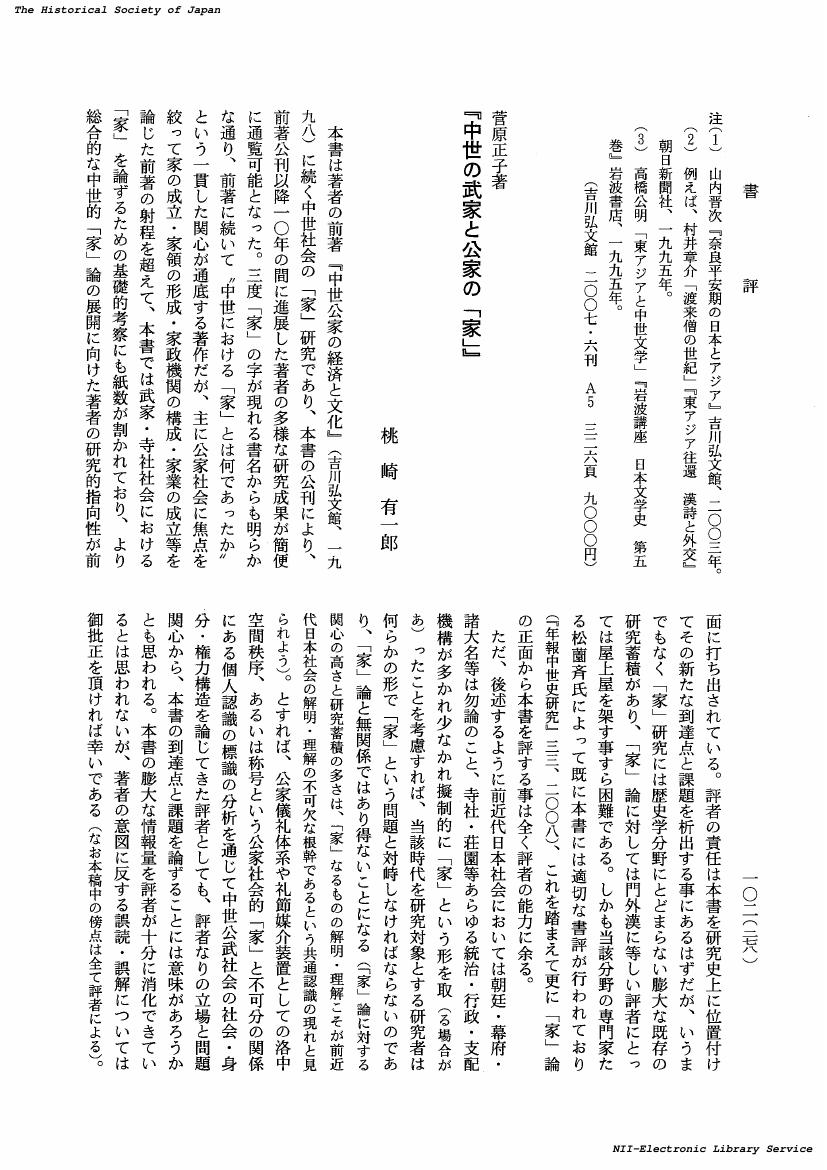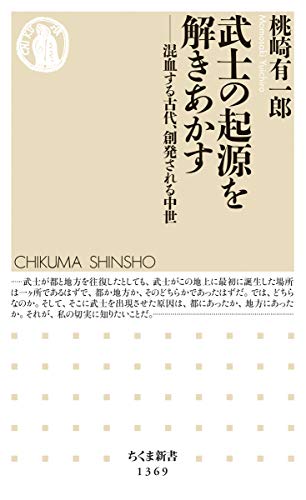44 0 0 0 OA 中世後期における朝廷・公家社会秩序維持のコストについて : 拝賀儀礼の分析と朝儀の経済構造
- 著者
- 桃崎 有一郎
- 出版者
- 慶應義塾大学
- 雑誌
- 史学 (ISSN:03869334)
- 巻号頁・発行日
- vol.76, no.1, pp.1-37, 2007-06
論文はじめに一 未拝賀の常態化と廷臣の経済的困窮 I 室町後期の未拝賀常態化 II 拝賀の負担感と廷臣の困窮 A 拝賀の負担感 B 洞院家の困窮と拝賀困難二 負担の内実と公家社会の経済構造 : 人件費と装束調達費 A 人件費の負担と訪に群がる人々 B 車・装束用意の負担三 廷臣の自衛策と負担回避の論理 A 拝賀先の省略 B 公事参仕の回避 C 拝賀回数の間引き D 複数の拝賀の「通用」 E 人員・装束の共有 F 人員・装束の削減・省略 G 任官・昇叙を所望せずおわりに
36 0 0 0 OA 中世里内裏陣中の構造と空間的性質について : 公家社会の意識と「宮中」の治安
- 著者
- 桃崎 有一郎
- 出版者
- 慶應義塾大学
- 雑誌
- 史学 (ISSN:03869334)
- 巻号頁・発行日
- vol.73, no.2, pp.195-223, 2004
論文はじめに一 南北朝・室町期の陣中とその存続下限 A 土御門内裏における陣中・陣口 B 牛車宣旨と陣中通行 C 陣口と「置石」二 陣中に対する公家社会の意識と慣行・治安おわりに
- 著者
- 桃崎 有一郎
- 出版者
- 慶應義塾大学
- 雑誌
- 史学 (ISSN:03869334)
- 巻号頁・発行日
- vol.73, no.1, pp.122-124, 2004
- 著者
- 桃崎 有一郎
- 出版者
- 公益財団法人 史学会
- 雑誌
- 史学雑誌 (ISSN:00182478)
- 巻号頁・発行日
- vol.118, no.2, pp.278-286, 2009-02-20 (Released:2017-12-01)
13 0 0 0 OA 目録学の構築と古典学の再生-天皇家・公家文庫の実態復原と伝統的知識体系の解明-
- 著者
- 田島 公 山口 英男 尾上 陽介 遠藤 基郎 末柄 豊 石上 英一 藤井 譲治 金田 章裕 西山 良平 坂上 康俊 西本 昌弘 本郷 真紹 加藤 友康 武内 孝善 田良島 哲 渡辺 晃宏 石川 徹也 石川 徹也 山口 和夫 藤原 重雄 稲田 奈津子 遠藤 珠紀 三角 洋一 月本 雅幸 吉川 真司 小倉 慈司 綾村 宏 杉橋 隆夫 桃崎 有一郎 島谷 弘幸 猪熊 兼樹 馬場 基
- 出版者
- 東京大学
- 雑誌
- 学術創成研究費
- 巻号頁・発行日
- 2007
禁裏(天皇家)や主要公家文庫収蔵史料のデジタル画像約100万件、東山御文庫本・伏見宮家本の1画像毎の内容目録約20万件を作成し、編纂所閲覧室での公開準備を進めた。木簡人名データベースと漢籍の受容を網羅した古代対外交流史年表を公開した。『禁裏・公家文庫研究』3・4、研究報告書4冊等を刊行し、禁裏・主要公家文庫の家分け蔵書目録を公開した。「陽明文庫講座」「岩瀬文庫特別連続講座」等市民向け公開講座を約百回開催し講演内容の一部を一般向けの本として刊行した
- 著者
- 桃崎 有一郎
- 出版者
- 日本史研究会
- 雑誌
- 日本史研究 = Journal of Japanese history (ISSN:03868850)
- 巻号頁・発行日
- no.684, pp.31-59, 2019-08
5 0 0 0 OA 日本目録学の基盤確立と古典学研究支援ツールの拡充-天皇家・公家文庫を中心に-
- 著者
- 田島 公 尾上 陽介 遠藤 基郎 末柄 豊 吉川 真司 金田 章裕 馬場 基 本郷 真紹 山本 聡美 伴瀬 明美 藤原 重雄 稲田 奈津子 黒須 友里江 林 晃弘 月本 雅幸 三角 洋一 川尻 秋生 小倉 慈司 渡辺 晃宏 桃崎 有一郎 北 啓太 吉岡 眞之 山口 英男 金子 拓 遠藤 珠紀 原 秀三郎 神尾 愛子 名和 修 名和 知彦 内海 春代 飯田 武彦
- 出版者
- 東京大学
- 雑誌
- 基盤研究(S)
- 巻号頁・発行日
- 2012-05-31
東京大学史料編纂所閲覧室で東山御文庫本、陽明文庫本、書陵部蔵九条家本・伏見宮家本など禁裏・公家文庫収蔵史料のデジタル画像約100万件を公開した。高松宮家伝来禁裏本・書陵部所蔵御所本の伝来過程を解明し、分蔵された柳原家本の復原研究を行い、禁裏・公家文庫収蔵未紹介史料や善本を『禁裏・公家文庫研究』や科学研究費報告書等に約30点翻刻・紹介した。更に、日本目録学の総体を展望する「文庫論」を『岩波講座日本歴史』22に発表し、『近衞家名宝からたどる宮廷文化』を刊行した。
- 著者
- 桃崎 有一郎
- 出版者
- 日本古文書学会
- 雑誌
- 古文書研究 (ISSN:03862429)
- 巻号頁・発行日
- no.68, pp.41-63, 2010-01
①共著の分担執筆「足利義嗣」(榎原雅治・清水克行編『室町幕府将軍列伝』、戎光祥出版、2017.10.10、pp.138-156)を公刊した。これは、足利義満の息子の一人義嗣の動向を洗い直すことで、義満が自分を中心とする新たな社会秩序やそれを表現する儀礼体系をどのように展開させようと構想していたかを論じたものである。本研究のテーマ「流鏑馬とは何だったのか」という問題は、武家儀礼全体を視野に入れるべきものであるため、足利義満期に中世の武家儀礼体系が一つの完成形を迎えることの意義は重大で、流鏑馬を含む武家儀礼がどのようなゴールへと向かっていったかを把握しておくことは、室町期に流鏑馬がなぜ廃れてしまったかを考える上で、不可欠の作業だったと考えている。②共著の分担執筆「古代における法と礼」「中世における法と礼」(高谷知佳・小石川裕介編著『日本法史から何がみえるか』、有斐閣、2018.3.10、pp.14-36,64-78)を公刊した。これは、日本の武家儀礼の根幹にある《礼》という規範が、そもそも日本の儀礼体系においていかなる役割を果たしたか、その前提として倭国段階のわが国が朝鮮半島経由で中国から《礼》を導入した時、わが国が《礼》を何であると理解し、何を吸収し、何を捨象し、法とのバランスをどこに求めたか、そしてその大前提として、古代中国において《礼》とはそもそも何であり、法といかなる関係に置かれてきたかを、儒教の経典や中国の史書の網羅的な調査、さらには殷代の甲骨文字まで遡って考察したものである。次の「現在までの進捗状況」で述べる理由により、この作業も本研究に欠かせないものだったと考えている。
研究課題に基づき、歴史学研究会においてシンポジウム報告を行い、室町幕府3代将軍足利義満から4代義持への世代交代に際して、朝廷・幕府を一身に統合的に支配する「室町殿」と呼ばれる地位が、義満期に更に上位の地位として形成された「北山殿」の地位と整理・統合され、「室町殿」という地位(とその呼称)が歴史上初めて確定・確立した事実を明らかにした。加えてその報告内容を、シンポジウムにおける質疑・批判を踏まえ、論文にまとめて投稿し、掲載された。また平行して、研究遂行過程で存在が確認された慶應義塾大学メディアセンター貴重書室所蔵の『北条家判尽』と題する巻子本について、踏み込んだ調査を行った。調査の結果、従来写本としてしか知られていなかった鎌倉〜南北朝期の幕府関係者の家に伝わった文書群の原本であることを明らかにし、その内容を紹介して従来の写本に基づく誤りを正すとともに、その伝来経緯・史料的価値・古文書学的価値について論じた。さらに従来はその内容が難解とされていた、鎌倉期公武関係の基礎史料というべき鎌倉幕府の公式記録『吾妻鏡』の現代語訳作業に取り組み、共著で刊行した。また研究課題に即した問題関心から、関連する研究書の書評を行い、問題の所在を指摘するとともに私見を提示した。なお上記の研究成果発表と平行して、研究課題達成のために公刊済み・未公刊を問わず関係史料の収集・蓄積と高野山金剛三昧院(和歌山県)・京都におけるフィールドワーク(史料調査・現地踏査)を継続的に行った。
- 著者
- 桃崎 有一郎
- 出版者
- 日本史研究会
- 雑誌
- 日本史研究 = Journal of Japanese history (ISSN:03868850)
- 巻号頁・発行日
- no.695, pp.3-36, 2020-07
1 0 0 0 綱光公記 : 宝徳二年四月~五月記
- 著者
- 遠藤 珠紀 須田 牧子 田中 奈保 桃崎 有一郎
- 出版者
- 東京大学史料編纂所
- 雑誌
- 東京大学史料編纂所研究紀要 (ISSN:09172416)
- 巻号頁・発行日
- no.30, pp.170-178, 2020-03
1 0 0 0 OA 中世公家社会における路頭礼秩序について : 成立・沿革・所作
- 著者
- 桃崎 有一郎
- 出版者
- 公益財団法人 史学会
- 雑誌
- 史学雑誌 (ISSN:00182478)
- 巻号頁・発行日
- vol.114, no.7, pp.1237-1260, 2005-07-20 (Released:2017-12-01)
How aristocrats and their entourages were to conduct themselves whenever boarding or deboarding their carriages on the open road (rotorei 路頭礼), which is found in Koan Reisetsu 弘安礼節, a manual of style approved by imperial order in 1285, can be traced back to the 10th century work Saikyuki 西宮記, which first outlined a framework for such procedures (called shajorei 車上礼). This framework was further developed into provisions about how bureaucrats were to conduct themselves in the presence of members of the imperial family, which are contained in the early Kamakura era collection of secret traditions, Sanjo Nakayama Kuden. It was through these traditions that rotorei was either directly or indirectly compiled into the official manual, Koan Reisetsu. Since rotorei was made necessary by the Japanese social elite's use of oxen-drawn carriages, vehicles which were not used among its counterparts in China, there are no provisions in the ritsu-ryo 律令 codes regarding their use or decorum. This is why the compilers of the Koan Reisetsu were forced to turn to various Japanese folk customs to systemize rotorei practices; as one Nanbokucho era summary of the Saikyuki laments, "there are no established rules, so we should rely on what is opportune at the moment to avoid any embarrassment." Here we notice a clear contrast between rules of decorum, like rotorei, that had to be systemized from indigenous custom and those, like bajorei 馬上礼 (horsemanship decorum), which were derived from the ritsuryo codes (especially those of the Tang Dynasty). In the former, we find detailed provisions about what to do in many different situations, like whether or not the oxen have been unhitched, clearly showing that in the case of any trouble, the parties involved would have use their own imaginations, a rule of thumb that also characterizes the manual of style regarding personal correspondence. We also find oral tradition and actual incidents from diaries, etc. being examined as precedents for conduct regarding such aspects as "backing the carriage,""unhitching the oxen,""positioning the step,""deboarding,""climbing down postures" and "bowing (prostrating) after deboarding." Such rules of deportment and the degree to which they were respected may add to a better understanding of the circumstances surrounding such incidents as Taira-no-Nobukane's arrow attack on Fujiwara-no-Yorinaga's carriage procession during the Hogen Civil War.
1 0 0 0 綱光公記 : 宝徳二年正月~三月記
- 著者
- 遠藤 珠紀 須田 牧子 田中 奈保 桃崎 有一郎
- 出版者
- 東京大学史料編纂所
- 雑誌
- 東京大学史料編纂所研究紀要 (ISSN:09172416)
- 巻号頁・発行日
- no.29, pp.133-144, 2019-03
1 0 0 0 得宗専制期における鎌倉幕府儀礼と得宗儀礼の基礎的再検討
- 著者
- 桃崎 有一郎
- 出版者
- 鎌倉遺文研究会 ; 1998-
- 雑誌
- 鎌倉遺文研究 (ISSN:13450921)
- 巻号頁・発行日
- no.41, pp.24-46, 2018-04
1 0 0 0 武士の起源を解きあかす : 混血する古代、創発される中世
- 著者
- 桃崎 有一郎
- 出版者
- 学習院大学史学会
- 雑誌
- 学習院史学 (ISSN:02861658)
- 巻号頁・発行日
- no.55, pp.17-43, 2017-03
1 0 0 0 綱光公記 : 文安六年(宝徳元年)四月~八月記
- 著者
- 遠藤 珠紀 須田 牧子 田中 奈保 桃崎 有一郎
- 出版者
- 東京大学史料編纂所
- 雑誌
- 東京大学史料編纂所研究紀要 (ISSN:09172416)
- 巻号頁・発行日
- no.27, pp.106-117, 2017-03




